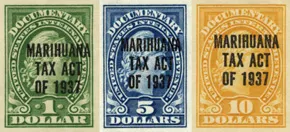One hundred years ago, the federal government was not overly concerned with marijuana, the common name for the Cannabis sativa L. plant. Initially spelled "marihuana," it was also known as hemp, Mary Jane, Mary Warner, and by variety of other terms. Most Americans seemed unaware of its presence, let alone its exploitation as a drug.
By the 1930s, several state governments and other countries had banned the drug. The U.S. government hesitated, in part because therapeutic uses of Cannabis were still being explored and American industry profited from commercial applications of hemp fiber, seeds and oil.
Marijuana was not classed as a major drug-unlike opium and heroin, which were prohibited under the Harrison Narcotics Tax Act of 1914 and subsequent restrictive legislation. As the political climate changed, Federal Bureau of Narcotics Commissioner Harry Anslinger became a powerful anti-marijuana voice. His campaign against Cannabis led to the passage of the Marihuana Tax Act of 1937, under which the importation, cultivation, possession and/or distribution of marijuana were regulated.
Among the act's provisions was one requiring importers to register and pay an annual tax of $24. A Marihuana Tax Act stamp, affixed to each original order form and marked by the revenue collector, insured that proper payments were made. The customs collector maintained custody of imported marijuana at the port of entry until required documents were received, with similar regulations governing marijuana exports. Shipments were subject to searches, seizures and forfeitures if any provisions of the law were not met. Violation of the act resulted in a fine of not more than $2,000 and/or imprisonment for up to five years.
In principle, the Marihuana Tax Act of 1937 stopped only the use of the plant as a recreational drug. In practice, though, industrial hemp was caught up in anti-dope legislation, making hemp importation and commercial production in this country less economical. Scientific research and medical testing of marijuana also virtually disappeared. By 1970, marijuana was classified and restricted on par with narcotics and new, tighter laws were enacted. Changes have occurred over the last 40 years. As of January 2012, 16 states and the District of Columbia have legalized marijuana for medical purposes, though this is still not permitted under federal regulations.
Just prior to the passage of the Marihuana Tax Act of 1937, the Customs Agency Service compiled a Narcotics Manual that reported: "Marihuana may be cultivated or grown wild in almost any locality. Inasmuch as this drug is so readily obtained in the United States, it is not believed to be the subject of much organized smuggling from other countries." Today, however, marijuana trafficking is a major concern of CBP, Immigration and Customs Enforcement and the Drug Enforcement Administration. Well over 3 million pounds of "pot" were confiscated at our borders in 2011, making an impact on this multibillion-dollar illegal enterprise.


